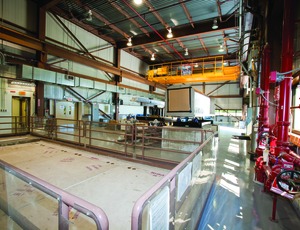U.S. Dept. of Energy laboratories are finishing up work on hundreds of millions of dollars worth of stimulus-funded infrastructure work that could accelerate research for breakthroughs in energy, medicine and other areas. However, transferring that research and development to the marketplace poses challenges.


U.S. Dept. of Energy laboratories are finishing up work on hundreds of millions of dollars worth of stimulus-funded infrastructure work that could accelerate research for breakthroughs in energy, medicine and other areas. However, transferring that research and development to the marketplace poses challenges.
Funding under the American Recovery and Reinvestment Act boosted work on conventional infrastructure at Fermi National Accelerator Laboratory, Batavia, Ill. Says Bruce Chrisman, the lab's chief operating officer, “[The funds] allowed us to jump-start some of the major experiments that we wanted to do so we can get them done sooner and faster.” About $25 million of the $114.3 million in stimulus funds that Fermi received went toward infrastructure upgrades and improvements, Chrisman says.
At Fermi, which focuses on high-energy physics and is DOE's largest lab, construction is nearly complete on a research building in which scientists will study superconducting materials for accelerator magnets and radiofrequency cavities. A.J. Maggio Co., Mt. Prospect, Ill., won the $3-million construction contract for the addition.
At two other Fermi buildings, expansions are being completed that will house superconducting radio-frequency cryomodules and test beam lines. Superconducting radio-frequency cavities at the lab could be applied to thorium reactors, a type of power generation that is more stable than uranium, Chrisman says.
Better Facilities, More R&D
At the Thomas Jefferson National Accelerator Facility in Newport News, Va., contractor S.B. Ballard, Virginia Beach, Va., broke ground in 2010 on upgrades that will double the energy capacity of its accelerator and allow for more precise experiments to help scientists better understand the nucleus of the atom.
The lab allocated $10 million in stimulus funds for general infrastructure upgrades, which included modifications to existing utility systems, construction of a new large acceptance detector for photon-beam experiments and installation of a new spectrometer system. The facility is not set to open until 2015, but DOE already is receiving requests from scientists to use it.
Fifteen companies, including Honeywell Controls and Dominion Power, were contracted to work on projects that include building a new experimental staging facility, road and parking improvements, a test-lab service transformer upgrade and a new 7,000-sq-ft end-station refrigerator building. Joe Scarcello, the Jefferson lab's chief financial officer, says construction is ahead of schedule.
At the SLAC National Accelerator Laboratory in Menlo Park, Calif., 363 companies were contracted to work on six projects that received $88 million in stimulus funding, says Mark Reichanadter, deputy COO. Work at the lab—which was known as the Stanford Linear Accelerator Center until it was renamed in 2008—includes a new electrical substation, infrastructure modernization, seismic upgrades and facilities for particle acceleration, he says.
Pushing Breakthroughs
About $150 million in funding allocated to Brookhaven National Laboratory in Upton, N.Y., will speed up parts of a new research laboratory, the National Synchrotron Light Source II. The project, set to finish in 2012, is ahead of schedule and has more than half of the ring constructed, according to Marty Fallier, a laboratory division director.
Once finished, scientists will use the technology to shoot strong beams of light and X-rays through various materials, which could lead to breakthroughs in energy, medicine and national security.
Torcon Inc., Red Bank, N.J., won the contract to build a ring-shaped 240,000-sq-ft accelerator building and associated beam lines, a 24,000-sq-ft building for the compact booster, a 10,600-sq-ft research facility and a 53,600-sq-ft storage building.







Post a comment to this article
Report Abusive Comment